Evaluation of Remuneration Structure of Woodside Petroleum and Santos
Added on 2023-06-07
28 Pages6167 Words289 Views
Running head: MANAGERIAL ACCOUNTING
Managerial Accounting
Name of the Student:
Name of the University:
Author’s Note:
Course ID:
Managerial Accounting
Name of the Student:
Name of the University:
Author’s Note:
Course ID:
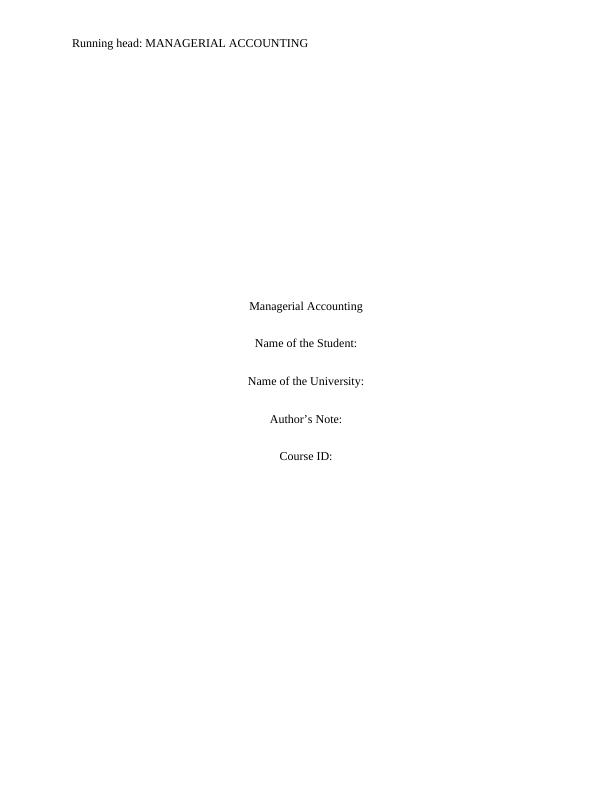
1MANAGERIAL ACCOUNTING
Executive Summary:
The current report is concerned with evaluating the remuneration structure of Woodside
Petroleum and its competitor, Santos in the Australian market. It has been evaluated that the
presence of an effective control system within the organisation is essential, as it helps in
improving the efficiency of the employees and reduces the level of slack conducted by the
workforce. Without an efficient control, system organisations are not able to reduce the level of
unethical practice within the organisation and control the attributes of their workforce. it is
inherent that Woodside Petroleum has maintained an effective remuneration structure in line
with its overall financial performance. However, deficiencies could be observed in the executive
remuneration structure of Santos because of the poor financial health in the Australian market.
The net income of Woodside has increased coupled with fall in outstanding shares for
Woodside and the situation is just the opposite for Santos due to negative net income. Hence, the
returns of the shareholders are maximised for Woodside Petroleum. It needs to be also seen that
there has been considerable amount of improvement as per the allocation of executive
remuneration for WoodSide petroleum in compared to Santos. In terms of the long term financial
highlight the company is depicted to be in a better position. This is evident with a cash flow
generation of $ 832 million.
Executive Summary:
The current report is concerned with evaluating the remuneration structure of Woodside
Petroleum and its competitor, Santos in the Australian market. It has been evaluated that the
presence of an effective control system within the organisation is essential, as it helps in
improving the efficiency of the employees and reduces the level of slack conducted by the
workforce. Without an efficient control, system organisations are not able to reduce the level of
unethical practice within the organisation and control the attributes of their workforce. it is
inherent that Woodside Petroleum has maintained an effective remuneration structure in line
with its overall financial performance. However, deficiencies could be observed in the executive
remuneration structure of Santos because of the poor financial health in the Australian market.
The net income of Woodside has increased coupled with fall in outstanding shares for
Woodside and the situation is just the opposite for Santos due to negative net income. Hence, the
returns of the shareholders are maximised for Woodside Petroleum. It needs to be also seen that
there has been considerable amount of improvement as per the allocation of executive
remuneration for WoodSide petroleum in compared to Santos. In terms of the long term financial
highlight the company is depicted to be in a better position. This is evident with a cash flow
generation of $ 832 million.
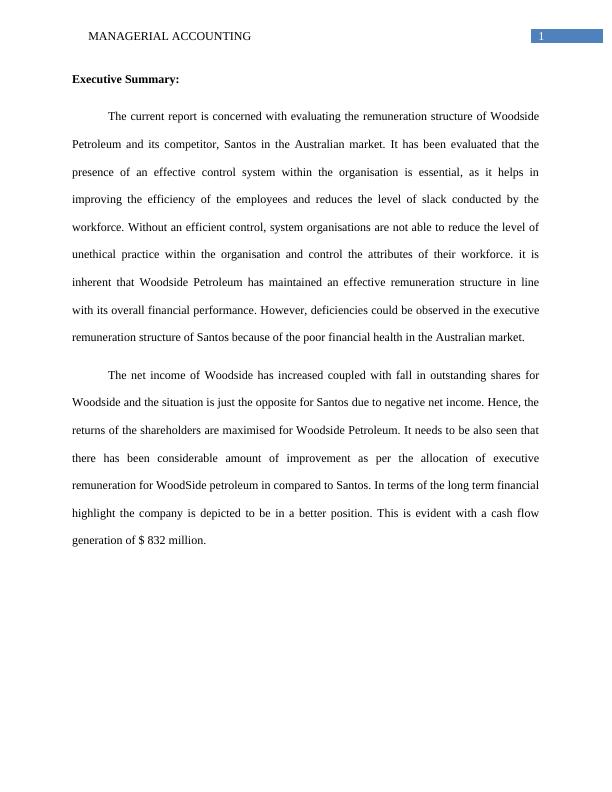
2MANAGERIAL ACCOUNTING
Table of Contents
1. Introduction:................................................................................................................................3
2. Review of topic and review of literature:....................................................................................3
2.1 Executive performance and remuneration in public companies:...........................................3
2.2 Effectiveness of control systems within companies:.............................................................5
3. Company reviews:.......................................................................................................................6
3.1 Details of remuneration committee and membership:...........................................................6
3.2 Allocation of executive remuneration:..................................................................................8
3.3 Mix of performance measures used:....................................................................................11
3.4 Company performance versus executive pay:.....................................................................17
4. Summary of findings:................................................................................................................19
5. Analysis and comparison of remuneration methods used:........................................................20
5.1 Best result in terms of shareholder returns:.........................................................................20
5.2 Best result in short-term:.....................................................................................................21
5.3 Best result in long-term:......................................................................................................22
6. Conclusion:................................................................................................................................23
References:....................................................................................................................................24
Table of Contents
1. Introduction:................................................................................................................................3
2. Review of topic and review of literature:....................................................................................3
2.1 Executive performance and remuneration in public companies:...........................................3
2.2 Effectiveness of control systems within companies:.............................................................5
3. Company reviews:.......................................................................................................................6
3.1 Details of remuneration committee and membership:...........................................................6
3.2 Allocation of executive remuneration:..................................................................................8
3.3 Mix of performance measures used:....................................................................................11
3.4 Company performance versus executive pay:.....................................................................17
4. Summary of findings:................................................................................................................19
5. Analysis and comparison of remuneration methods used:........................................................20
5.1 Best result in terms of shareholder returns:.........................................................................20
5.2 Best result in short-term:.....................................................................................................21
5.3 Best result in long-term:......................................................................................................22
6. Conclusion:................................................................................................................................23
References:....................................................................................................................................24
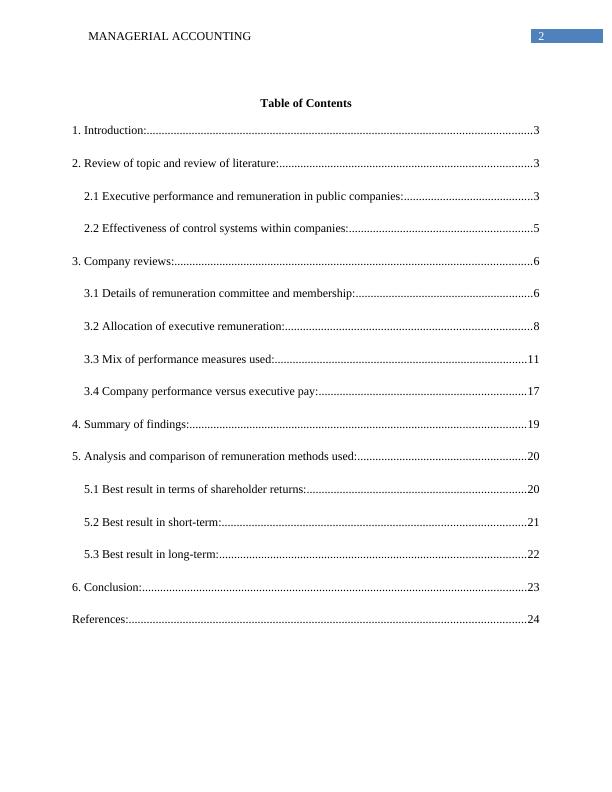
3MANAGERIAL ACCOUNTING
1. Introduction:
The report aims in identifying the role of remuneration, which is depicted in the annual
report of an organisation. Remuneration report is mainly depicted in the annual report as per the
rulings of Companies Act, where the organisation needs to detect all the remuneration that has
been provided to the directors of the company. Remuneration report also allows the investors to
understand the level of income, which is generated by the directors of the company during
declining profit and improving earnings. The report mainly exists to evaluate the remuneration
report of Woodside Petroleum for the fiscal year of 2017. Further evaluation on the company is
conducted in the overall assessment where its remuneration report is analysed, while other
financial performance measures are also taken into consideration. With the summary of findings
and the comparison of the remuneration report, the assessment portrays the company’s
performance over the fiscal years.
2. Review of topic and review of literature:
2.1 Executive performance and remuneration in public companies:
Both executive performance evaluation and remuneration in public companies are
depicted in the annual report of the organisation. The remuneration report depicted in the
financial statement directly indicates the level of bonuses and monetary benefits that has been
provided to the directors and executives of the organisation. This identified remuneration system
is adequately evaluated by the auditors and regulator to identify whether the organisation is
correctly providing remunerations to its directors and executives. In this context, Riaz, et al.,
(2015) stated that organisation with the help of remuneration report is able to detect the level of
1. Introduction:
The report aims in identifying the role of remuneration, which is depicted in the annual
report of an organisation. Remuneration report is mainly depicted in the annual report as per the
rulings of Companies Act, where the organisation needs to detect all the remuneration that has
been provided to the directors of the company. Remuneration report also allows the investors to
understand the level of income, which is generated by the directors of the company during
declining profit and improving earnings. The report mainly exists to evaluate the remuneration
report of Woodside Petroleum for the fiscal year of 2017. Further evaluation on the company is
conducted in the overall assessment where its remuneration report is analysed, while other
financial performance measures are also taken into consideration. With the summary of findings
and the comparison of the remuneration report, the assessment portrays the company’s
performance over the fiscal years.
2. Review of topic and review of literature:
2.1 Executive performance and remuneration in public companies:
Both executive performance evaluation and remuneration in public companies are
depicted in the annual report of the organisation. The remuneration report depicted in the
financial statement directly indicates the level of bonuses and monetary benefits that has been
provided to the directors and executives of the organisation. This identified remuneration system
is adequately evaluated by the auditors and regulator to identify whether the organisation is
correctly providing remunerations to its directors and executives. In this context, Riaz, et al.,
(2015) stated that organisation with the help of remuneration report is able to detect the level of
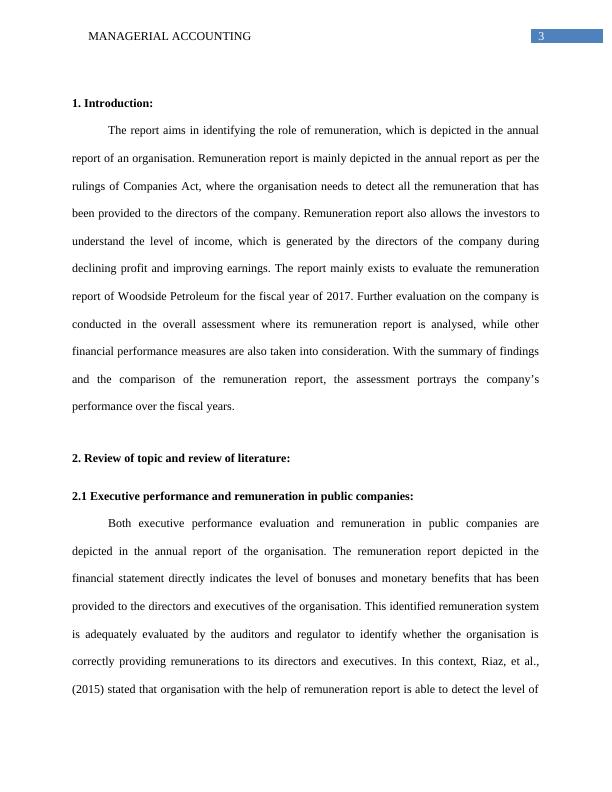
4MANAGERIAL ACCOUNTING
income that is distributed to directors and executives of the organisation. The level of
remuneration that is provided to the directors is considered to be as bonuses for the efforts
delivered by the Managing Directors. On the other hand, Hooghiemstra, Kuang and Qin (2017)
argued that investors are able to evaluate the loopholes in the current accounting system of
organisations, when they are able to identify that high remunerations are provided to director
while the organisation is making losses.
The remuneration report directly involved different types of methods that are used by the
organisation in paying the directives and executives. There are two different levels of payment
such as share-based payments and monetary payments. The organisation mainly provide share
based payment to the director and executive for long duration, while restricting the level of trees
that could be conducted for a particular period. This eventually helps in supporting the overall
share value of the organisation if the directors and executive think of selling their portion of
shares. Furthermore, the monetary benefit that is provided by the organisation is mainly for the
services that were conducted during the fiscal year. The bonuses are based on future share based
payments, which are provided to the executive for their services during the fiscal year.
According to Faghani, Monem and Ng (2015), the remuneration provided by the company to the
executive is based on the performance evaluation, which is conducted on annual basis to identify
the most efficient executive of the company. Moreover, Riaz, et al., (2015) indicated that
motivating the executive with monetary benefits for an effort during the fiscal year eventually
helps in improving the motivation level of employees. Therefore, with the remuneration report,
the organisation is able to detect the level of expenses that is conducted on executives and
directors for their initiatives. This eventually allows the investors to detect the level of expenses
income that is distributed to directors and executives of the organisation. The level of
remuneration that is provided to the directors is considered to be as bonuses for the efforts
delivered by the Managing Directors. On the other hand, Hooghiemstra, Kuang and Qin (2017)
argued that investors are able to evaluate the loopholes in the current accounting system of
organisations, when they are able to identify that high remunerations are provided to director
while the organisation is making losses.
The remuneration report directly involved different types of methods that are used by the
organisation in paying the directives and executives. There are two different levels of payment
such as share-based payments and monetary payments. The organisation mainly provide share
based payment to the director and executive for long duration, while restricting the level of trees
that could be conducted for a particular period. This eventually helps in supporting the overall
share value of the organisation if the directors and executive think of selling their portion of
shares. Furthermore, the monetary benefit that is provided by the organisation is mainly for the
services that were conducted during the fiscal year. The bonuses are based on future share based
payments, which are provided to the executive for their services during the fiscal year.
According to Faghani, Monem and Ng (2015), the remuneration provided by the company to the
executive is based on the performance evaluation, which is conducted on annual basis to identify
the most efficient executive of the company. Moreover, Riaz, et al., (2015) indicated that
motivating the executive with monetary benefits for an effort during the fiscal year eventually
helps in improving the motivation level of employees. Therefore, with the remuneration report,
the organisation is able to detect the level of expenses that is conducted on executives and
directors for their initiatives. This eventually allows the investors to detect the level of expenses
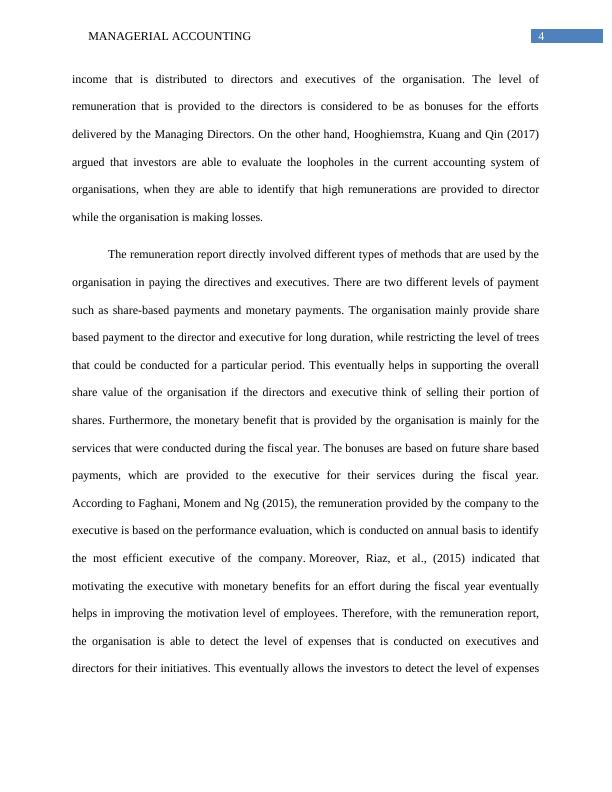
5MANAGERIAL ACCOUNTING
and determine whether the remuneration amount is feasible and viable for the directors or
executives.
2.2 Effectiveness of control systems within companies:
Presence of an effective control system within the organisation is essential, as it helps in
improving the efficiency of the employees and reduces the level of slack conducted by the
workforce. Without an efficient control, system organisations are not able to reduce the level of
unethical practice within the organisation and control the attributes of their workforce. Scott
(2015) mentioned that without the presence of adequate control system within the organisation
the management is not able to exercise decisions, which could improve productivity and
efficiency of the company. Without the presence of an adequate control system businesses are
not able to develop and execute strategic plans, which helps in generating higher revenue in the
end. Therefore, it could be understood that organisations using the control system are able to
fulfil their objectives and obtain sustainable growth by adequately utilising the available
resources. The organisation also needs to have an adequate internal control system to support the
legal and regulatory standards that has been imposed by the adequate authorities. Hence, it could
be understood that without the presence of effective control system organisations are not able to
operate their 100%, which directly affects their capability to reach higher levels of revenue and
income (Argyris, 2017).
There are different benefits of an effective control system, which can be used by the
organisation to improve the timing of their decision making process. Furthermore, an effective
control system would increase the quality of information that can be received by different
departments of the organisation (Kerzner and Kerzner, 2017). This eventually helps in
minimising the lead-time that is taken for transferring data from one department to other. This
and determine whether the remuneration amount is feasible and viable for the directors or
executives.
2.2 Effectiveness of control systems within companies:
Presence of an effective control system within the organisation is essential, as it helps in
improving the efficiency of the employees and reduces the level of slack conducted by the
workforce. Without an efficient control, system organisations are not able to reduce the level of
unethical practice within the organisation and control the attributes of their workforce. Scott
(2015) mentioned that without the presence of adequate control system within the organisation
the management is not able to exercise decisions, which could improve productivity and
efficiency of the company. Without the presence of an adequate control system businesses are
not able to develop and execute strategic plans, which helps in generating higher revenue in the
end. Therefore, it could be understood that organisations using the control system are able to
fulfil their objectives and obtain sustainable growth by adequately utilising the available
resources. The organisation also needs to have an adequate internal control system to support the
legal and regulatory standards that has been imposed by the adequate authorities. Hence, it could
be understood that without the presence of effective control system organisations are not able to
operate their 100%, which directly affects their capability to reach higher levels of revenue and
income (Argyris, 2017).
There are different benefits of an effective control system, which can be used by the
organisation to improve the timing of their decision making process. Furthermore, an effective
control system would increase the quality of information that can be received by different
departments of the organisation (Kerzner and Kerzner, 2017). This eventually helps in
minimising the lead-time that is taken for transferring data from one department to other. This
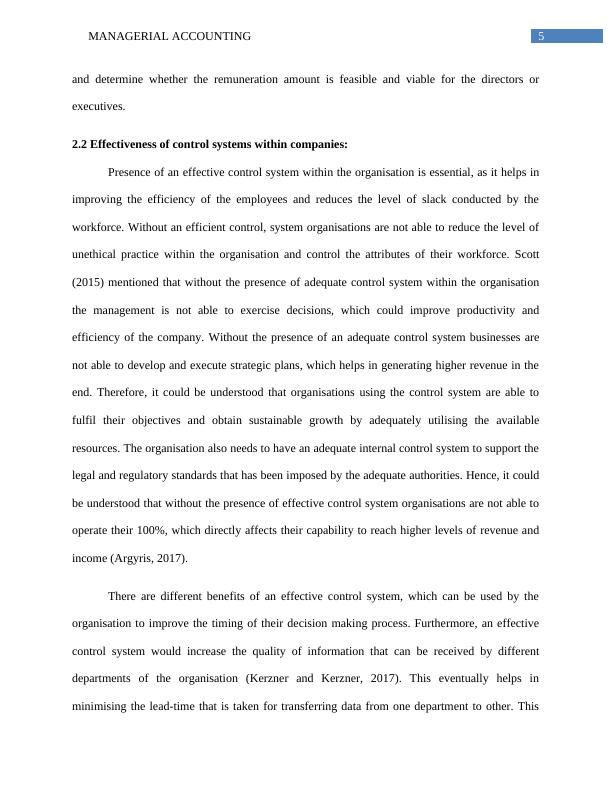
End of preview
Want to access all the pages? Upload your documents or become a member.
Related Documents
Executive Performance Evaluation and Remuneration in Public Companies: A Review of Woodside Petroleum and Santos for the Fiscal Year of 2017lg...
|18
|1945
|363
Financial Analysis of Santos Limited: Comparative Analysis with Woodside Petroleumlg...
|14
|2058
|4
Evaluation of Remuneration Structures of Reliance Worldwide and Alcidion Group Limitedlg...
|8
|1740
|74
Effectiveness of Control Systems Within Companieslg...
|18
|1487
|118
Financial Management Presentation 2022lg...
|9
|991
|24
Introductory Accountinglg...
|8
|1487
|21